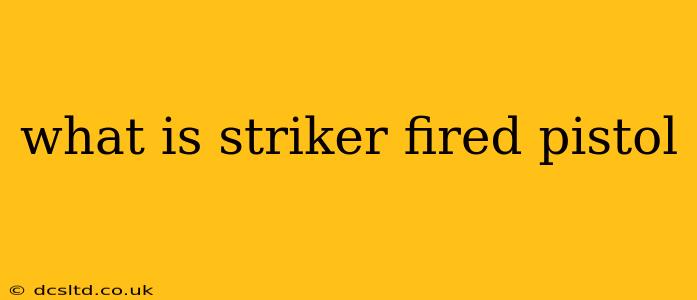A striker-fired pistol is a type of handgun that uses a striker—a spring-loaded firing pin—to ignite the cartridge's primer. Unlike pistols with hammers, there's no separate hammer to cock before firing. The striker is cocked automatically when the slide cycles, making it ready to fire when the trigger is pulled. This design offers several advantages and disadvantages that we'll explore in detail.
How Does a Striker-Fired Pistol Work?
The core mechanism is simple yet effective. When the slide moves rearward, it cocks the striker, compressing its spring. As the slide returns to its forward position, the striker remains cocked. Pulling the trigger releases the striker, causing it to impact the primer and ignite the cartridge. This straightforward action contributes to the generally lighter trigger pull and simpler design compared to hammer-fired pistols.
What are the Advantages of Striker-Fired Pistols?
- Simpler Design & Maintenance: Fewer moving parts mean less that can go wrong and easier cleaning and maintenance.
- Generally Lighter Trigger Pull: This often leads to faster target acquisition and improved accuracy, especially for those with less hand strength. However, it's crucial to note that this lighter pull can also contribute to accidental discharges if proper safety procedures aren't followed.
- Ambidextrous Operation (Often): Many striker-fired pistols feature ambidextrous slide release levers and magazine releases, making them suitable for both right-handed and left-handed shooters.
- Cost-Effectiveness: Due to their simpler design, they're often more affordable to manufacture, resulting in a lower price point for consumers.
- Reduced Recoil (Sometimes): The design can sometimes contribute to slightly less felt recoil, depending on the specific model and caliber.
What are the Disadvantages of Striker-Fired Pistols?
- Accidental Discharges (Potential): The lighter trigger pull can increase the risk of accidental discharge if the gun isn't handled properly. This is a crucial point and emphasizes the importance of safe gun handling practices regardless of the firearm type.
- Lack of Manual Safety (Often): Many striker-fired pistols lack a manual safety, relying instead on trigger safety mechanisms. While this can contribute to a faster draw, it also necessitates greater care in handling.
- Trigger Travel and Reset: While the trigger pull might be lighter, the travel distance and reset can vary widely between models, affecting shooting performance and shooter preference.
- Striker Failure (Rare): Although rare, potential striker failure is a possibility, but proper maintenance and responsible ownership greatly mitigate this risk.
Are Striker-Fired Pistols More Reliable Than Hammer-Fired Pistols?
The reliability of both striker-fired and hammer-fired pistols depends heavily on the specific make, model, and maintenance. Both designs can be highly reliable when properly maintained and used. It's not a matter of one design inherently being more reliable than the other. However, the simpler mechanism of a striker-fired pistol can contribute to reduced opportunities for malfunction in some instances.
How Do Striker-Fired Pistols Compare to Hammer-Fired Pistols?
The primary difference lies in the ignition system. Hammer-fired pistols use a separate hammer that needs to be cocked before firing, while striker-fired pistols have an internal striker that's automatically cocked when the slide cycles. This results in differences in trigger pull, safety mechanisms, and overall design complexity. The best choice depends entirely on individual preferences, shooting style, and intended use.
What are Some Popular Striker-Fired Pistols?
Many popular handguns utilize a striker-fired mechanism. Examples include, but are not limited to, the Glock series, the Smith & Wesson M&P series, and the Springfield XD series. Each model has its unique features and specifications, catering to different needs and preferences. Researching individual models is essential before purchasing.
This information is for educational purposes only. Always handle firearms safely and responsibly, and consult with a qualified firearms instructor before handling any firearm. This content does not constitute legal or professional advice.
